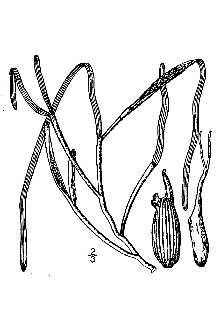Zostera marina L. var. stenophylla Asch. & Graebn.
Scientific Name: Zostera marina L. var. stenophylla Asch. & Graebn.

| General Information | |
|---|---|
| Usda Symbol | ZOMAS |
| Group | Monocot |
| Life Cycle | Perennial |
| Growth Habits | Forb/herb |
| Native Locations | ZOMAS |
Plant Guide
Use a soil moisture meter to monitor the soil moisture where Zostera marina L. var. stenophylla Asch. & Graebn. is planted.
Fact Sheet
Alternate Names
Common Alternate Names: seawrack, tapegrass
Uses
Native American cultures consumed the leaf bases and rhizomes of eelgrass and used the bulk plant material for smoking meats. Eelgrass was once harvested for use as stuffing in mattress manufacture prior to industrial production of synthetic fibers. Due to its low flammability, dried eelgrass shoots were also used as housing insulation. In addition, watermen frequently ship live blue crabs (Callinectes sapidus) in eelgrass-packed boxes. Eelgrass is desirable for nearshore restoration, due to its ability to stabilize sediments and reduce erosion. Seagrass restoration is also a tool for improving water quality and providing habitat for various aquatic and coastal species.
Status
Eelgrass populations, along with other submerged plants, have declined over the past 40 years due to poor water quality in coastal regions. Poor water quality is a result of increased turbidity due to sediment from runoff and algal blooms associated with eutrophication. Populations have declined most significantly in Delaware Bay (almost completely absent) and Chesapeake Bay (reduced). Please consult the PLANTS Web site and your State Department of Natural Resources for this plant’s current status (e.g., threatened or endangered species, state noxious status, and wetland indicator values).
Description and Adaptation
Adaptation , Use soil moisture sensors to measure the soil moisture of Zostera marina L. var. stenophylla Asch. & Graebn..
Adaptation
Eelgrass has a thick, creeping underground stem (rhizome), 2 to 5 cm long, with many roots and nodes spaced 1 to 3.5 cm apart. Alternate ribbon-like leaves with rounded tips arise from these nodes and grow up to 1.2 m long and 2 to 12 mm wide, hence the alternate name tapegrass. Depending upon region and water clarity, eelgrass may grow in depths of less than 3 m (east coast United States) or in depths of more than 5 m (Pacific Northwest coast United States). Eelgrass growing in shallow, sandy substrates (eelgrass prefers sandy sediments) tends to have shorter leaves, whereas plants in deeper, muddy, quiet conditions have longer leaf growth. Reproduction is both sexual and asexual. Plants flower in late spring and each plant contains male and female flowers (monoecious). Flowers are fertilized by drifting pollen. Seeds develop on specialized reproductive shoots (spathes) that eventually break off and float to the surface where they drift and release seeds. For asexual reproduction, the rhizome grows and elongates, sending up new shoots. Entire beds may consist of clones from one original plant. Eelgrass is a true seagrass, requiring minimum salinities of 10 PSU (Practical Salinity Unit, a unit of measure based on the properties of seawater conductivity) or greater. It grows along both coasts of North America, ranging from North Carolina to Labrador on the east coast, and from Baja, California north to southeastern Alaska. It has a worldwide distribution in coastal waters of similar conditions. Eelgrass distribution from USDA-NRCS PLANTS Database. For updated distribution, please consult the Plant Profile page for this species on the PLANTS Web site.
Establishment
Eelgrass beds are well established in coastal regions with appropriate salinity and water quality. Restoration in regions currently devoid of eelgrass beds is achieved either through transplanting of adult plants or through seed dispersal.
Management
Eelgrass beds are critical habitat for a variety of commercially and recreationally important aquatic species, including the blue crab, juveniles of a variety of commercially important finfish, and several species of shorebirds. Because of their economic importance, eelgrass beds are managed so that impacts or destructive activities are prohibited. Such activities include, but are not limited to boating (due to prop scars) and hydraulic clam dredging (due to destruction of beds).
Pests and Potential Problems
Eelgrass is susceptible to wasting disease caused by infestation of Labyrinthula zosterae, previously classified as a slime mold, but genetically more closely related to stramenopiles, a large algal group. Eelgrass populations in the North Atlantic were severely impacted by the wasting disease in the 1930s. The remaining populations appear to coexist with moderate levels of Labyrinthula with rare outbreaks leading to mortality. Plants are directly consumed by a variety of migratory birds.
Environmental Concerns
Due to the deterioration of water quality in many coastal areas over the past 40 years eelgrass populations have declined. The lack of sunlight penetrating the water column is the most likely cause of this decline. Because of the many ecological benefits from eelgrass, there is concern about the environmental impacts associated with its decline. In addition, increasing ocean temperatures predicted by climate change models are likely to cause a shift in the species distribution to more northern climates, as eelgrass cannot tolerate warm water.
Control
Eelgrass is a native species that regularly colonizes marine habitats. It is not invasive, and therefore no chemical applications or physical removal is justified. In many areas it is protected from destruction or removal by state and/or federal regulatory agencies. Cultivars, Improved, and Selected Materials (and area of origin) Current research centers on seed-based approaches to restoring eelgrass beds. Seeds used for restoration must be harvested from naturally-occurring populations as eelgrass has not been successfully propagated in a controlled setting.
Prepared By
Robert F. Murphy, Leslie L. Orzetti and Wesley R. Johnson, Ecosystem Solutions, Inc.
